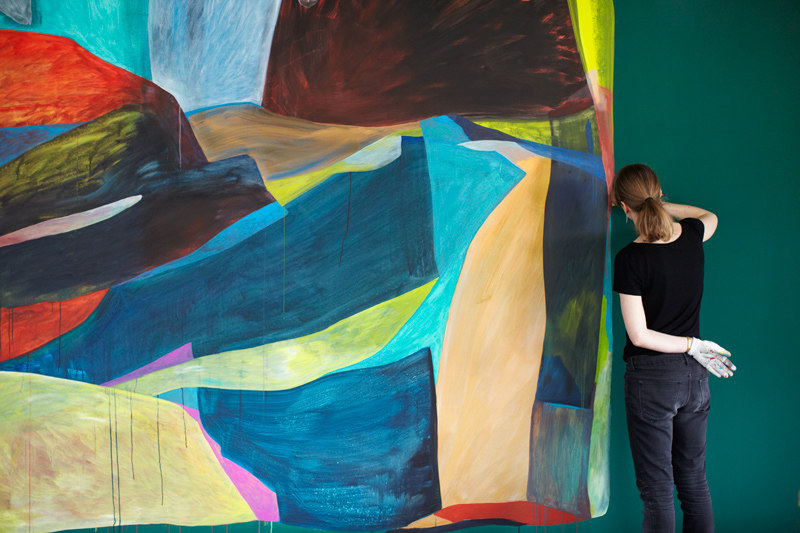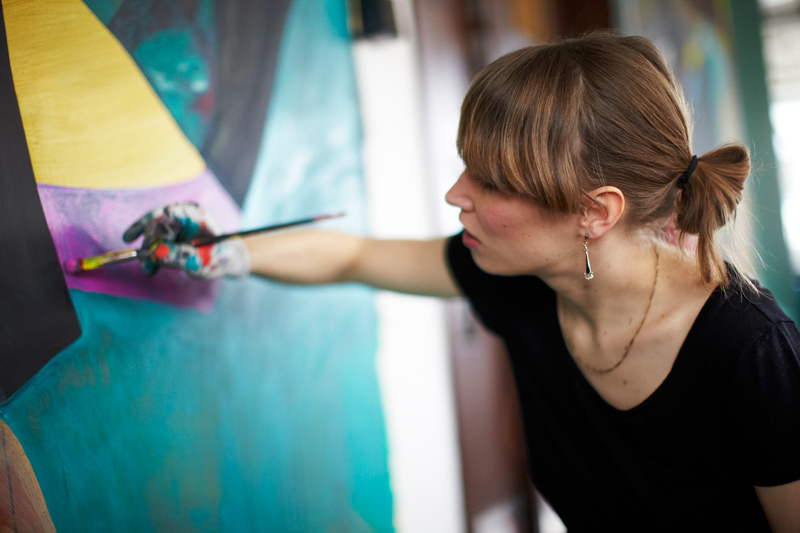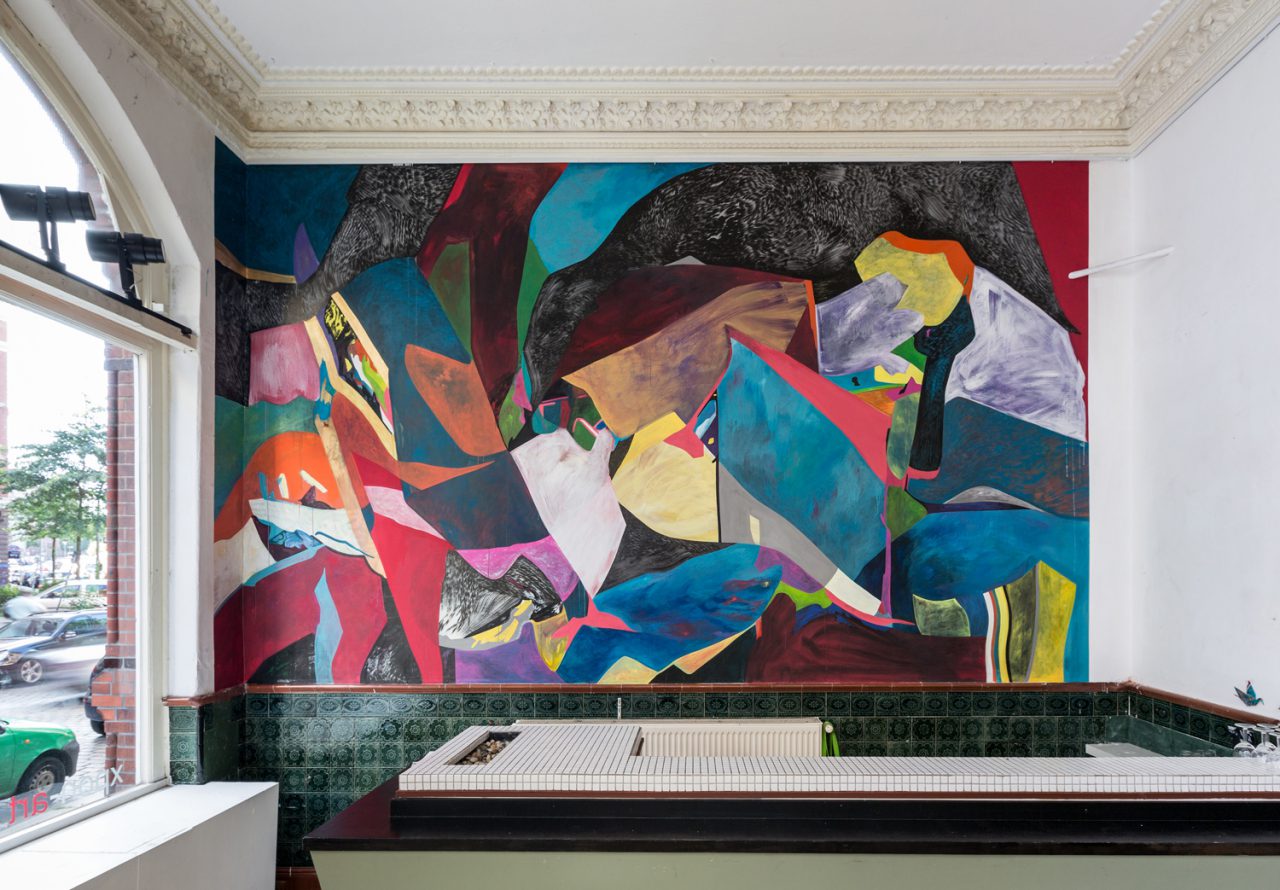
STEFAN LEYH
...Page is loading...

© Daniela Müller-Brunke
Berlin, Germany
One thing is clear: painting has changed. At the end of the last century
it was already being stated that the standardisation of contemporary
image production under the general term of painting tends to obscure the
differences that now exist both within the medium and in relation to what
has historically been called painting.1 Since then, at least, painting has no
longer been a matter of idealistic utopias; the...
One thing is clear: painting has changed. At the end of the last century
it was already being stated that the standardisation of contemporary
image production under the general term of painting tends to obscure the
differences that now exist both within the medium and in relation to what
has historically been called painting.1 Since then, at least, painting has no
longer been a matter of idealistic utopias; the foreground is now mainly
occupied by painterly questions formulated in an awareness of their social
and institutional framework. Reflection on painting’s own history and
the examination of its relationship to other media, including the so-called
‘new’ ones and the image worlds they generate, are the parameters of
contemporary painterly production. The question is that of the medium’s
self-definition and self-assertion in the network of mutually pervasive and
influential experiences of seeing.
For some time now there has also been an increasing tendency for nonrepresentative
painting to abandon traditional formats or, if it doesn’t, to
question them fundamentally. So it’s all the more surprising that Ivonne
Dippmann, who isn’t exclusively a painter, and who attracted attention
with such things as printed clothing, huge wall pieces, portable metal
sculptures and collages, has now placed a distinct accent on the painted
canvas.
The reason for this is explained in a brief look at her exhibition’s apparently
simple title, which flippantly reduces Mies van der Rohe’s very widely
known oxymoron ‘less is more’ to the trivial statement of the factually
correct More Is More. Behind this is an attitude of wanting to speak less to
baroque exhilaration – although Dippmann obviously has nothing against
opulent colouration – than in the radical cadence of Ad Reinhardt and his
statement ‘Art is art. Everything else is everything else.’ If we remember
that the text which Reinhardt’s quotation originally introduced was written
at a time when in the wake of abstract expressionism the reception of
non-representational painting primarily functioned through the construction
of transcendental truths beyond the works themselves, we can discern
the background against which Dippmann’s works are positioned. A development
was then beginning in which abstraction gained a new dimension
in the dialogue between painting and space. Psychological elements had
had their day.
This art requires an attitude towards it that isn’t only intellectual but
presupposes a particular distance under particular lighting conditions in
specially staged spaces. In More is More the autonomous canvas
undoubtedly dominates the space, but it is entirely anti-contemplative,
that is unsuitable for meditative immersion. Autonomy and inner necessity,
the key competences of classical painting, are abandoned in favour of
strategies that obtain their legitimacy from other images and really existing
circumstances. Multipart paintings, for example, are hung around corners
so that they can’t be perceived as a unity; yet they paradoxically overwrite
the space and redefine it. And there is the addition of a disconcerting
wall painting that recalls a loom and can be classed somewhere between
textile image and metal sculpture.
Here the artist draws directly on conceptions of the work that have to do
with simple, material existence instead of subjectively justified creation. At
the same time she plays with the usual gender-specific ascriptions of the
art world, which likes to assign absurd hierarchies of material and media
to their users. A reflex that Dippmann satirises in numerous, sometimes
wearable textile works.
It is a commonly upheld stereotype that art by women circles around the
body and identity. And it is equally claimed that performance is something
for women, along with everything remotely connected with textiles. ‘Don’t
paint – it’s a men’s world’, said Katharina Grosse, passing on the warnings
of her professors at the Kunstakademie Düsseldorf to Siri Hustvedt during
a conversation at the exhibition Queensize.2 She was certainly referring
to her large canvases, and above all the extensive wall paintings, such as
Ivonne Dippmann repeatedly creates.
The wearing of textiles on the body in connection with performance as a
definition of space was in fact introduced into post-war German modernism
by a man – Franz Erhardt Walther. This type of spatialised textile work
has only undergone a few essential changes or amendments since then. Its
main proponent has been the American artist Andrea Zittel, whose blankets
and items of clothing are explicitly designed to be used. Zittel’s model
is clearly the Bauhaus, with its aspiration to bring together the applied and
fine arts. In this sense Dippmann’s textiles are exemplary in the way they
question the traditional boundaries of the genre. They lightly bridge the
gap between academic artistic discourse and handiwork, mediate optical
and haptic space and at the same time address the old question of transferring
three-dimensional space onto a surface.
A further minefield of contemporary art that Dippmann ventures into is
the discussion around colour. Involvement with it generally strikes intellectuals
as dubious. Contours are somehow felt to be clear and distinct,
colour more vague and emotional. Perhaps Dippmann sticks to her guns
for this very reason, continually thinking about the ambivalent relationship
between these two cornerstones of painting. Characteristic here are
leaps between abstraction and figuration – often within a single work.
In contrast to the works of preceding years, which bound colours to the
concrete forms of her preliminary sketch, similarly to colouring-in drawings,
Dippmann’s most recent figures are in fact entirely swathed in colour
fields. They wear abstraction as a costume, as it were. Contrary to the early
small-format images of people and what might be landscapes, the colours
are now superimposed. What functions as an undercolour in one place
can appear elsewhere as a dominant final layer, until the colour fields
ultimately dissolve into loose formations in which one tone flows seamlessly
into another.
For Dippmann, as for McKenzie Wark, abstraction also means ‘to construct
a plane upon which otherwise different and unrelated matters may be
brought into many possible relations’.3 Deleuze and Guattari’s old image
of the rhizome lends itself well to Dippmann’s way of working. Rhizomes,
like the tubers of one-year-old plants, store nutrients, and what is special
about them is that in contrast to other forms of root they are ‘democratic’,
that is they don’t mark a power relation. There is no leading form to which
all other phenotypes work towards. So as soon as a certain size has
been reached they can be divided for propagation at any random point.
Applied to Dippmann’s work it can be said that although not every work
inevitably refers to a similar one, they all ceaselessly establish ‘connections
between semiotic chains, organisations of power, and circumstances relative
to the arts, sciences and social struggles’4 in their own characteristic
way and through the means of art. This also explains the many apparent
contradictions in the artist’s still emergent work. She appears to have no
interest in formally tying herself down. The only recognisable constant is
that her painting and thought processes always inform one another,
coupling in quite different exhibition constellations in pursuit of allembracing
form.
Susanne Prinz
Translation: Michael Turnbull
1 Stefan Germer, ‘Vorsicht, Frisch gestrichen – Thesen zu älteren und
neueren Medien’, in Texte zur Kunst, vol. 31, 1998, pp. 60–65
2 https://www.youtube.com/watch?v=2LwaVr_OgZE, access: 7.1.2016
3 McKenzie Wark, A Hacker Manifesto, version 4.0, http://subsol.c3.hu/
subsol_2/contributors0/warktext.html, access: 25.1.2016
4 Gilles Deleuze/Félix Guattari, A Thousand Plateaus, London 1988
(Text to the show "More is More", Clb Berlin 2016)

Double Spread Monography "Meine Feindseligkeiten Sind Gerechtfertigt Verteilt" (engl.: My Hostilities Are Distributed In A Justified Way), Revolver Publishing 2013 | © Studio Ivonne Dippmann

Ivonne Dippmann WV 2015 - 021, 022 | 2 x neckline negative, patinated, Ø 20 cm, 2/4 brass objects, production in cooperation with Juliwerk, from an edition of 14 handcrafted unique items, Berlin 2015 © Katrin Greiner

Ivonne Dippmann WV 2015 – 220 until 231/269 | NIKE Air, acrylic, gouache, ink, spraypaint on paper, from a series of 50 drawings , each 100×70 cm, Berlin 2015 | © Studio Ivonne Dippmann

Ivonne Dippmann WV 2015 – 218 | Passed cement in gray/beige, triptych, acrylic, gouache, ink, spraypaint on canvas, 290×420 cm © Michael Belogour, GfjK Baden-Baden 2015

Ivonne Dippmann WV 2016 – 008 bis 015 I WALLS I – VIII, I In winter the trails are not gritted here. II I liked her, that is the better word. III Leave me alone! I’m amused! IV Flowers, which I do not know. V Until the whiskey etched up the ribbons. VI Remainder world. VII Attention! Roof avalanches! VIII In a complete peace of mind in the midst of ruins., from a series of 8 paintings (I – VIII), acrylic, ink, spray paint, gouache on canvas, each 6×140 x 290 cm & 2×200 x 290 cm, total 760×290 cm, Berlin 2016

Ivonne Dippmann WV 2016 – 016 Saal 6, Reihe B, Sitz 5, Acryl, Tusche, Gouache auf Rehgipswand, Gesamt 1500×250 cm, Ivonne Dippmann, Open space area, 6th floor, Mindspace Berlin 2016 © Daniela Müller-Brunke

Ivonne Dippmann WV 2016 – 016 Saal 6, Reihe B, Sitz 5, Acryl, Tusche, Gouache auf Rehgipswand, Gesamt 1500×250 cm, Ivonne Dippmann, Open space area, 6th floor, Mindspace Berlin 2016 © Daniela Müller-Brunke

Ivonne Dippmann WV 2015 – 220 | Paul, acrylic, ink, gouache on wall, total 280×200 cm, Ivonne Dippmann, lobby Mindspace Berlin 2015 © Daniela Müller-Brunke

Ivonne Dippmann WV 2016 – 033 | At the Kaiserkai, acrylic, ink, gouache on wall, 305×532 cm, Hamburg 2016 © Helge Mundt

Ivonne Dippmann WV 2016 – 034 | Out of sight, please continue reading!, acrylic, ink, gouache, spray paint on canvas, steel frame, cable ties black, black rope, rotating, 200×160×35 cm, Berlin 2016
What is it about your studio space that inspires you?
To have everything in one place. To be alone.
What sounds, scents and sights do you encounter while in your studio?
Birds.
What is your favourite material to work with? How has your use of it evolved throughout your practice?
Paper. I always get back to it while trying to work with everything else.
If you weren´t an artist, what would you be doing?
Surfing the world.
What are your favourite places besides your studio?
The ocean and my bed.
2017
THE CAT WAS QUIET UNTIL MORNING, Galerie Rainbow Unicorn, Berlin
EINER FLÜSTERT DEM ANDEREN INS OHR, Galerie Kornhaus, Gmünder Kunstverein
2016
MEHR IST MEHR, CLB Berlin, Deutschland
show all
2016
über[s]malen, xpon-art gallery, Hamburg, Deutschland
T€MPORAR¥ PARADI$€, Rainbow Unicorn, Berlin, Deutschland
RE(A)LATIONS Ivonne Dippmann & Torben Giehler, eingeladen von DAG (Dag Pryzbilla)
show all
2001 - 2009 UNIVERSITÄT DER KÜNSTE, Berlin, Deutschland
2003 - 2004 UNIVERSIDAD PAIS VASCO, Bilbao, Spanien
2004 CALIFORNIA COLLEGE OF THE ARTS, San Francisco, USA
show all